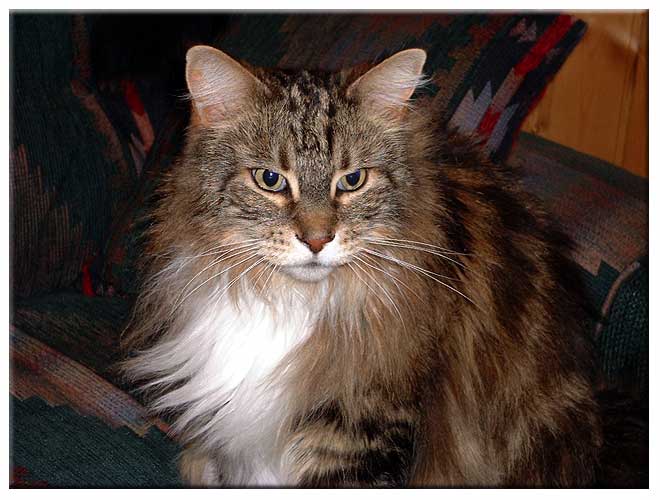
The college years got me into rod building too. I had refurbished a couple old cane rods back before I learned to drive, and Bill bought me the Wonder rod and my first 22 when he got out of the army in '56. By the time I got to college, Herters was the big name in do-it-yourself sporting stuff. I built guns and rods during the college years and shot the National Match schedule for three years. Hunting was a 22 with a scope for squirrels thing in the fall, and shooting and fishing kept me the rest of the year. I did lots of glass rods on Herters and Lamiglas blanks in the late 50's and early 60's and started fishing the small mountain streams of Virginia in earnest when I came down this way after college. The mountain streams were dry fly territory, and I fell right into the dry fly purist trap in a matter of a couple years. I honestly have never really gotten over it. I relapse to woolies and streamers from time to time, but never have my heart with them. Coaxing a trout up from the cobbles to sample a carefully drifted dry is the ultimate fishing experience for me and probably always will be.
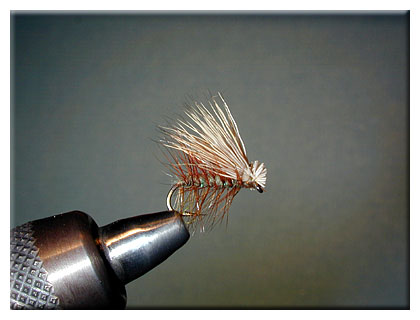 I've tried about every dry fly combination possible over the years, but caddis imitations have dominated my interest for a long time now. The Elk Hair Caddis is probably the most accepted caddis pattern there is, and I started with it years ago, never really liking to tie it or cope with its fragileness. The palmered hackle was a bear to tie, never lasted very well, and made the fly have a rather awkward stance on the water. It skitters well, though, and catches fish for sure. I tied a bunch of them for several years. In digging around this morning, I found several old boxes full of them. I honestly haven't used them for probably 25 years, though.
I've tried about every dry fly combination possible over the years, but caddis imitations have dominated my interest for a long time now. The Elk Hair Caddis is probably the most accepted caddis pattern there is, and I started with it years ago, never really liking to tie it or cope with its fragileness. The palmered hackle was a bear to tie, never lasted very well, and made the fly have a rather awkward stance on the water. It skitters well, though, and catches fish for sure. I tied a bunch of them for several years. In digging around this morning, I found several old boxes full of them. I honestly haven't used them for probably 25 years, though.
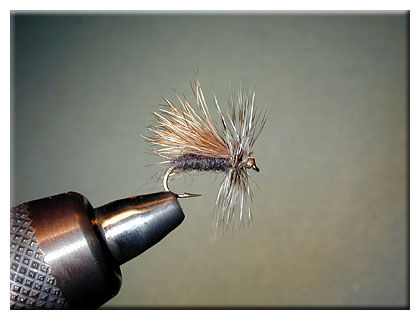 My first ties were Coachman's and Catskill ties and simple no-wing dries, so a tail and a dubbed body and a hackle at the eye were what a dry fly was supposed to be, in my experience. The Whirling Caddis worked kind of like that, though it didn't have a tail. I tied it with an elk hair wing pretty much like on an Elk Hair Caddis but trimmed it close in the front and put a hackle at the eye like I was used to. I used that pattern for a long time and liked the way it sat on the water. The fish seemed to be pretty enthusiastic about it, and it held up much better than the fragile Elk Hair Caddis with its palmered hackle that always broke on the first fish.
My first ties were Coachman's and Catskill ties and simple no-wing dries, so a tail and a dubbed body and a hackle at the eye were what a dry fly was supposed to be, in my experience. The Whirling Caddis worked kind of like that, though it didn't have a tail. I tied it with an elk hair wing pretty much like on an Elk Hair Caddis but trimmed it close in the front and put a hackle at the eye like I was used to. I used that pattern for a long time and liked the way it sat on the water. The fish seemed to be pretty enthusiastic about it, and it held up much better than the fragile Elk Hair Caddis with its palmered hackle that always broke on the first fish.
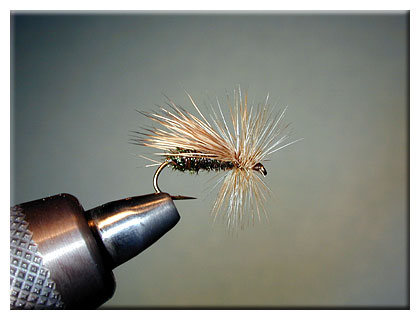 I've always liked peacock on flies. It has an iridescence and a natural roughness that is just plain buggy. I began tying the Whirling Caddis with a peacock body and felt I had the best possible combination. I guess that one was an old pattern, too, since I saw both it and the the Whirling Caddis in the Orvis catalog back in the mid 60's and wondered if they had come up with the idea on their own like I had. Funny about fly patterns, everybody who makes some changes to some standard ties thinks he has something new. I know for sure that just about everything has been tried and proven before any of us gets to it. New is a mindset, I'm afraid.
I've always liked peacock on flies. It has an iridescence and a natural roughness that is just plain buggy. I began tying the Whirling Caddis with a peacock body and felt I had the best possible combination. I guess that one was an old pattern, too, since I saw both it and the the Whirling Caddis in the Orvis catalog back in the mid 60's and wondered if they had come up with the idea on their own like I had. Funny about fly patterns, everybody who makes some changes to some standard ties thinks he has something new. I know for sure that just about everything has been tried and proven before any of us gets to it. New is a mindset, I'm afraid.
The Peacock Caddis kept me in fish during my first trips to Montana in the late 70's. I remember catching a nice 18" brown in the lower Gibbon Meadow late one evening in June in 1979 on a Peacock Caddis drifted against a deep bank run. I was more than pleased. The Park had stocked a bunch of grayling that year, and they just loved the little fly. Fat, little, silvery fellows rose to it one after another for several afternoons that trip.
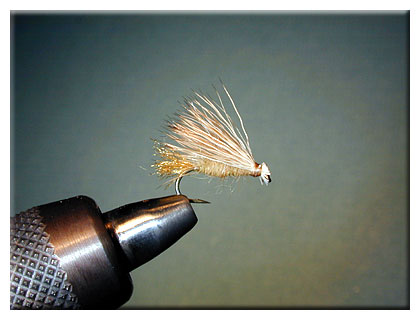 During the 80's I got to know Craig Mathews and the fellows at his shop, Blue Ribbon Flies, and developed a lot of respect for their fly patterns. Sparkle Duns became my spring fare on the Firehole and their X Caddis began to replace the Peacock Caddis for my evening fishing. It floated pretty well and sat very low in the water imitating an emerger quite well. It was deadly during last light when the emergence was really in full swing. A cast across and down got strong takes by healthy rainbows up at Fountain Flat most every evening in late June.
During the 80's I got to know Craig Mathews and the fellows at his shop, Blue Ribbon Flies, and developed a lot of respect for their fly patterns. Sparkle Duns became my spring fare on the Firehole and their X Caddis began to replace the Peacock Caddis for my evening fishing. It floated pretty well and sat very low in the water imitating an emerger quite well. It was deadly during last light when the emergence was really in full swing. A cast across and down got strong takes by healthy rainbows up at Fountain Flat most every evening in late June.
Gary LaFontaine came along with his Caddis book about that time and I began to experiment with Antron Caddis type flies and emergers in general. The value of a shuck as a tail like on Craig's X Caddis made sense to me. I toyed with his various caddis patterns for a couple years, coming up with variations on his themes but usually falling back to the X Caddis and my ever changing versions of the Whirling and Peacock Caddis flies. Finally by the mid 80's I was putting Zelon shucks on the tails of all my caddis flies just like Gary LaFontaine and Craig Mathews were doing with their ties. I don't know if the shuck made any difference but it surely didn't hurt.
It was really those experiments that developed into the Tweeter Caddis. Basically the Tweeter was a Whirling Caddis fly with a Zelon tail. I tied it in light colors, primarily, and used a light golden Zelon tail on all of them. Craig tied the X Caddis with a tan or a green body. My Tweeter Caddis was basically the tan X Caddis with a cree hackle at the eye. I used a little darker elk hair than he did and a little lighter body, but the basic fly was his X Caddis with a Whirling Caddis hackle at the eye.
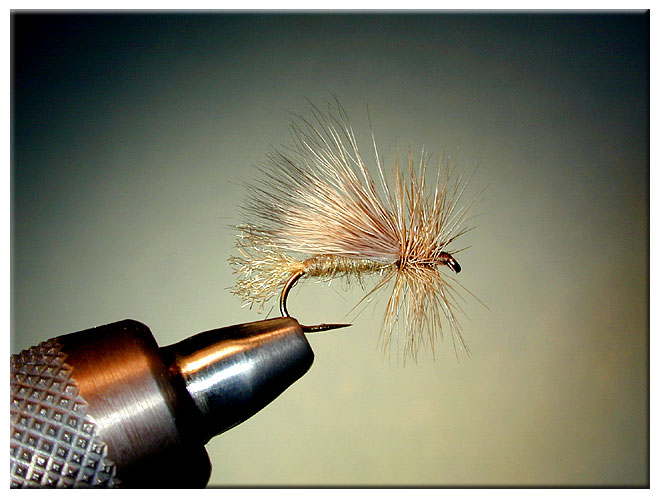 We've always had cats it seems. Catman came to us when we moved to the Bridges Store property in the mid 70's. He adopted Mary Lu, and it was all a cat world from there on. By the end of the 80's all the original cats had gotten old and passed on. We found ourselves catless in the fall of 1991. Having had a couple cats killed on the highway, we made up our minds to have only inside cats from then on. We bought Tweeter and Applause from show people, then. Both were pure bred Maine Coon cats, wonderfully big long-haired boys with a pleasantness and earnestness not to be matched. Applause latched onto Mary Lu just like Catman did years before. I looked over on the couch just now and he is sitting on top of her while she reads. Tweeter became my boy right from the start.
We've always had cats it seems. Catman came to us when we moved to the Bridges Store property in the mid 70's. He adopted Mary Lu, and it was all a cat world from there on. By the end of the 80's all the original cats had gotten old and passed on. We found ourselves catless in the fall of 1991. Having had a couple cats killed on the highway, we made up our minds to have only inside cats from then on. We bought Tweeter and Applause from show people, then. Both were pure bred Maine Coon cats, wonderfully big long-haired boys with a pleasantness and earnestness not to be matched. Applause latched onto Mary Lu just like Catman did years before. I looked over on the couch just now and he is sitting on top of her while she reads. Tweeter became my boy right from the start.
The first summer at the Montana home found me at the vise again and the thought of using Tweeter's natural brown under fur as dubbing material was a charming encounter, and I gave it a try. The soft grayish under fur spun like beaver and looked as natural as a real caddis. It absorbed water like a sponge, though, and made the flies sink almost immediately. I went back to my usual synthetic dubbing, but the name was obvious. The Tweeter Caddis was born.
Tweeter and his namesake have stuck with me to the present. I just about always use a Tweeter Caddis as my searching fly when there isn't anything else obvious to change my mind. It works for evening caddis emergences. It does a fine job for sparse dun hatches. It coaxes the quick boys out of the riffles and brings the big boys up from the bottom in the slicks. It floats well and imitates just about anything that lives on the top of the water. Stone flies look like it. Small hoppers are an easy match. Even most terrestrials are fairly close much of the time. If I had to have only one fly in my box the Tweeter would be a no-brainer.

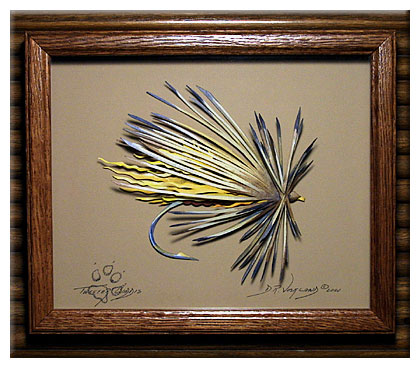 I've even made it an art subject. Loucas Raptis in Victoria, BC used the Tweeter as the subject for a color pencil drawing and shadow box display he did for me a couple years ago. Debra Volkland of Olathe, Kansas turned the Tweeter into a wonderful cut paper shadow box framed sculpture a year ago for me. Wildlife artist, Kurt Vitch is including a Tweeter Caddis fly in his westslope cutthroat carving he is doing for me right now. The Tweeter Caddis will probably always be the most important fly in my fly box and will probably always be a focal point in my life.
I've even made it an art subject. Loucas Raptis in Victoria, BC used the Tweeter as the subject for a color pencil drawing and shadow box display he did for me a couple years ago. Debra Volkland of Olathe, Kansas turned the Tweeter into a wonderful cut paper shadow box framed sculpture a year ago for me. Wildlife artist, Kurt Vitch is including a Tweeter Caddis fly in his westslope cutthroat carving he is doing for me right now. The Tweeter Caddis will probably always be the most important fly in my fly box and will probably always be a focal point in my life.
Late last winter Tweeter stopped jumping up on the table to sit on my right arm as I ate my morning cereal. Two nights in a row he failed to come to bed and wrap himself around my head on top of my pillow like he had done for more than ten years. He walked slowly and ate sparingly and lacked the glint in his eye when I rubbed him. His purr was still strong and he still rubbed the side of his face against my nose when I knelt down to him, but he was just not right. We took him to Jim our vet and I called my friend Bill for advice. Blood tests revealed a tremendous white cell count. X-rays revealed fluid filling his chest cavity. His breathing was strained and the fluid revealed incurable lymphoma. Saturday we took him to the continuous care facility in Staunton in hopes of keeping him comfortable and maybe bringing him back, but we lost him Sunday morning. Mary Lu buried him behind the house under the upstairs office where I sit most of the day during the winter.
It has been more than six months now since Tweeter left us. I've not gotten much over the loss. He is still as fresh to me sitting here right now as he ever was. I can feel his warmth around my head at night and feel his presence on the breakfast table every morning. I can see him here beside my chair putting his paw on my leg to get my attention. We let our children grow up and break their ties with us, but we keep our pets close to our hearts every minute of their lives. I think Tweeter knew that I needed him perhaps more than he needed me. He was generous enough to keep me warm and secure for eleven years. I miss him a lot.

© Dave Lewis 2003


 I've tried about every dry fly combination possible over the years, but caddis imitations have dominated my interest for a long time now. The Elk Hair Caddis is probably the most accepted caddis pattern there is, and I started with it years ago, never really liking to tie it or cope with its fragileness. The palmered hackle was a bear to tie, never lasted very well, and made the fly have a rather awkward stance on the water. It skitters well, though, and catches fish for sure. I tied a bunch of them for several years. In digging around this morning, I found several old boxes full of them. I honestly haven't used them for probably 25 years, though.
I've tried about every dry fly combination possible over the years, but caddis imitations have dominated my interest for a long time now. The Elk Hair Caddis is probably the most accepted caddis pattern there is, and I started with it years ago, never really liking to tie it or cope with its fragileness. The palmered hackle was a bear to tie, never lasted very well, and made the fly have a rather awkward stance on the water. It skitters well, though, and catches fish for sure. I tied a bunch of them for several years. In digging around this morning, I found several old boxes full of them. I honestly haven't used them for probably 25 years, though. My first ties were Coachman's and Catskill ties and simple no-wing dries, so a tail and a dubbed body and a hackle at the eye were what a dry fly was supposed to be, in my experience. The Whirling Caddis worked kind of like that, though it didn't have a tail. I tied it with an elk hair wing pretty much like on an Elk Hair Caddis but trimmed it close in the front and put a hackle at the eye like I was used to. I used that pattern for a long time and liked the way it sat on the water. The fish seemed to be pretty enthusiastic about it, and it held up much better than the fragile Elk Hair Caddis with its palmered hackle that always broke on the first fish.
My first ties were Coachman's and Catskill ties and simple no-wing dries, so a tail and a dubbed body and a hackle at the eye were what a dry fly was supposed to be, in my experience. The Whirling Caddis worked kind of like that, though it didn't have a tail. I tied it with an elk hair wing pretty much like on an Elk Hair Caddis but trimmed it close in the front and put a hackle at the eye like I was used to. I used that pattern for a long time and liked the way it sat on the water. The fish seemed to be pretty enthusiastic about it, and it held up much better than the fragile Elk Hair Caddis with its palmered hackle that always broke on the first fish. I've always liked peacock on flies. It has an iridescence and a natural roughness that is just plain buggy. I began tying the Whirling Caddis with a peacock body and felt I had the best possible combination. I guess that one was an old pattern, too, since I saw both it and the the Whirling Caddis in the Orvis catalog back in the mid 60's and wondered if they had come up with the idea on their own like I had. Funny about fly patterns, everybody who makes some changes to some standard ties thinks he has something new. I know for sure that just about everything has been tried and proven before any of us gets to it. New is a mindset, I'm afraid.
I've always liked peacock on flies. It has an iridescence and a natural roughness that is just plain buggy. I began tying the Whirling Caddis with a peacock body and felt I had the best possible combination. I guess that one was an old pattern, too, since I saw both it and the the Whirling Caddis in the Orvis catalog back in the mid 60's and wondered if they had come up with the idea on their own like I had. Funny about fly patterns, everybody who makes some changes to some standard ties thinks he has something new. I know for sure that just about everything has been tried and proven before any of us gets to it. New is a mindset, I'm afraid. During the 80's I got to know Craig Mathews and the fellows at his shop, Blue Ribbon Flies, and developed a lot of respect for their fly patterns. Sparkle Duns became my spring fare on the Firehole and their X Caddis began to replace the Peacock Caddis for my evening fishing. It floated pretty well and sat very low in the water imitating an emerger quite well. It was deadly during last light when the emergence was really in full swing. A cast across and down got strong takes by healthy rainbows up at Fountain Flat most every evening in late June.
During the 80's I got to know Craig Mathews and the fellows at his shop, Blue Ribbon Flies, and developed a lot of respect for their fly patterns. Sparkle Duns became my spring fare on the Firehole and their X Caddis began to replace the Peacock Caddis for my evening fishing. It floated pretty well and sat very low in the water imitating an emerger quite well. It was deadly during last light when the emergence was really in full swing. A cast across and down got strong takes by healthy rainbows up at Fountain Flat most every evening in late June. We've always had cats it seems. Catman came to us when we moved to the Bridges Store property in the mid 70's. He adopted Mary Lu, and it was all a cat world from there on. By the end of the 80's all the original cats had gotten old and passed on. We found ourselves catless in the fall of 1991. Having had a couple cats killed on the highway, we made up our minds to have only inside cats from then on. We bought Tweeter and Applause from show people, then. Both were pure bred Maine Coon cats, wonderfully big long-haired boys with a pleasantness and earnestness not to be matched. Applause latched onto Mary Lu just like Catman did years before. I looked over on the couch just now and he is sitting on top of her while she reads. Tweeter became my boy right from the start.
We've always had cats it seems. Catman came to us when we moved to the Bridges Store property in the mid 70's. He adopted Mary Lu, and it was all a cat world from there on. By the end of the 80's all the original cats had gotten old and passed on. We found ourselves catless in the fall of 1991. Having had a couple cats killed on the highway, we made up our minds to have only inside cats from then on. We bought Tweeter and Applause from show people, then. Both were pure bred Maine Coon cats, wonderfully big long-haired boys with a pleasantness and earnestness not to be matched. Applause latched onto Mary Lu just like Catman did years before. I looked over on the couch just now and he is sitting on top of her while she reads. Tweeter became my boy right from the start.
 I've even made it an art subject. Loucas Raptis in Victoria, BC used the Tweeter as the subject for a color pencil drawing and shadow box display he did for me a couple years ago. Debra Volkland of Olathe, Kansas turned the Tweeter into a wonderful cut paper shadow box framed sculpture a year ago for me. Wildlife artist, Kurt Vitch is including a Tweeter Caddis fly in his westslope cutthroat carving he is doing for me right now. The Tweeter Caddis will probably always be the most important fly in my fly box and will probably always be a focal point in my life.
I've even made it an art subject. Loucas Raptis in Victoria, BC used the Tweeter as the subject for a color pencil drawing and shadow box display he did for me a couple years ago. Debra Volkland of Olathe, Kansas turned the Tweeter into a wonderful cut paper shadow box framed sculpture a year ago for me. Wildlife artist, Kurt Vitch is including a Tweeter Caddis fly in his westslope cutthroat carving he is doing for me right now. The Tweeter Caddis will probably always be the most important fly in my fly box and will probably always be a focal point in my life.